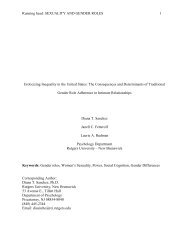Sources of self-categorization as minority for mixed race individuals
Sources of self-categorization as minority for mixed race individuals
Sources of self-categorization as minority for mixed race individuals
You also want an ePaper? Increase the reach of your titles
YUMPU automatically turns print PDFs into web optimized ePapers that Google loves.
<strong>Sources</strong> <strong>of</strong> Self-Categorization 11participants indicated that they were <strong>of</strong> part-White biracial or multiracial descent. Participantsethnicities were <strong>as</strong> follows: 47 Black/White, 35 Asian/White, 6 Latino/White, 5 NativeAmerican/White, 3 Black/Latino/White, 6 Black/Native American/White, 1 Asian/Black/White,1 Asian/Latino/White, 1 Asian/Black/Native American/White, 1 Asian/Latino/NativeAmerican/White, 1 Black/Latino/Native American/White. At the end <strong>of</strong> the online survey, we<strong>as</strong>ked participants to indicate how they had heard about the study: 16% were members <strong>of</strong>multiracial campus organizations (non-Rutgers), 18% were Rutgers University students, 22%received the link to the survey from online facebook and yahoo group advertisements, 30%reported receiving the link in an e-mail from a friend, and 14% <strong>of</strong> the sample did not indicate ananswer to the question.Materials and ProcedureAll materials were presented in an online survey hosted by surveymonkey.com. Afterindicating their in<strong>for</strong>med consent, participants completed me<strong>as</strong>ures tailored to their <strong>minority</strong>ancestry (African American, Asian, Latino, or Native American) by <strong>as</strong>king participants whetherone <strong>of</strong> their biological parents w<strong>as</strong> African American, or Asian, etc. and then branching them toidentical questions that referenced their African American or Asian identity. Fourteen multiracialparticipants completed the me<strong>as</strong>ures <strong>for</strong> more than one <strong>minority</strong> ethnicity. To collapse acrossthose participants, the ethnicity indicated <strong>as</strong> most important 2 w<strong>as</strong> used to create the generalMinority variables <strong>for</strong> those multiracial participants. The final questions on the survey <strong>as</strong>kedparticipants to indicate their age, gender, and highest education completed. The l<strong>as</strong>t page <strong>of</strong> thesurvey fully debriefed participants.Minority connectedness. The degree to which participants felt connected to their ethniccommunity w<strong>as</strong> <strong>as</strong>sessed with 4 items: “I think that Asian people understand me better than other



